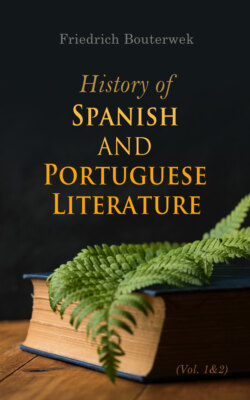Читать книгу History of Spanish and Portuguese Literature (Vol. 1&2) - Friedrich Bouterwek - Страница 37
На сайте Литреса книга снята с продажи.
SAA DE MIRANDA.
ОглавлениеTable of Contents
The fame of the great reform of the Castilian poetry having penetrated into Portugal, a similar reform took place in the poetry of that nation. At this time the Castilian language was held in such high consideration in Portugal, that even Portuguese poets, without undervaluing their national tongue, thought themselves bound occasionally to write verses in Castilian, to entitle them to be regarded as perfect masters of the poetic art. In the first half of the sixteenth century, two of the most celebrated of these Portuguese poets laboured with such success to extend the dominion of Castilian pastoral poetry, that the thread of the history of Spanish literature would be broken, were a notice of the poetic merits of these two celebrated men confined solely to the history of the literature of Portugal. One of them, Francisco de Saa de Miranda, who was born in 1494, and died in 1558, belongs, however, in so eminent a degree, to his own nation, and the circumstances of his life are so closely connected with the history of Portuguese poetry, that it would be an injustice to Portuguese literature to rank him exclusively among the poets of Spain. Besides, most of his poetic works, with the exception of his pastoral poems, are written in the Portuguese language.191 The other Portuguese poet, who claims attention in the history of Spanish poetry, is Jorge de Montemayor. He, through his residence in Spain, became wholly a Spaniard:—the work to which he chiefly owes his celebrity is written in Spanish; and he had so decided an influence on Spanish literature, that this would be the proper place for introducing an account of his short life and of his poetry, did not Saa de Miranda’s Castilian pastorals, which are of older date, demand a previous notice.192
The bucolic effusions of Saa de Miranda exhibit in their general tone more traits of resemblance to Theocritus, than are to be found in the writings of Garcilaso de la Vega. Garcilaso’s pastoral style, with all its simplicity, was not sufficiently rural for Saa de Miranda. Like Theocritus his feelings seem to have dictated to him pure rural ideas; and he transferred this characteristic of his Portuguese eclogues to those which he wrote in Spanish, which are the most numerous. Nevertheless, even in his rural poems he did not wish to renounce the attributes of the loftier style of poetry. He was, however, heedless of all critical distinction of the different kinds of poetry, and would, without scruple, commence a poem, in the metre of an Italian canzone, as an ode, proceed with it in epic metaphors,193 and conclude it in the simplest idyllic style. With equal indifference he chose sometimes octave verse, sometimes tercets for his pastoral poems, which thus alternately assume a lyric and a dramatic tone. This capricious mixture of poetic genera and styles deteriorates in no slight degree the quality of Saa de Miranda’s poetry. The elevated tone of the ode forms a singular contrast when introduced in the same composition along with the easy familiar style, which, in the opinion of Saa de Miranda, the pure pastoral character of his poetry required. But no modern poet has succeeded so well in the union of simplicity and grace; and in this respect the eclogues of Saa de Miranda are unequalled. When he describes the gambols of the nymphs, with whom his fancy animates his native woodland scenes;194—when he sketches impetuous storms of passion, softened by the charm of his colouring, yet kept true to nature;195—when he introduces nymphs discoursing;196—or, when he abandons himself to a tone of elegiac melancholy;197—one knows not whether most to admire, the delicate truth and penetrating depth of his ideas, or the artless precision and facility of his expression. In such cases he often abandons the natural style of Theocritus for a more lofty or ideal manner. When, in some of his other eclogues, his shepherds converse on their occupations or superstitions,198 he likewise departs from the prosaic nature of real pastoral life, such as he had the opportunity of observing in his native country, and gradually elevates it to romantic ideality. It happened, however, that he occasionally found the prosaic truth of his pictures sufficiently interesting, and then to be truly natural he avoided all embellishment.199
Some of Saa de Miranda’s popular songs, called Cantigas, a term which in Portuguese corresponds with Villancicos in Spanish, are inimitable for grace and simplicity.200
